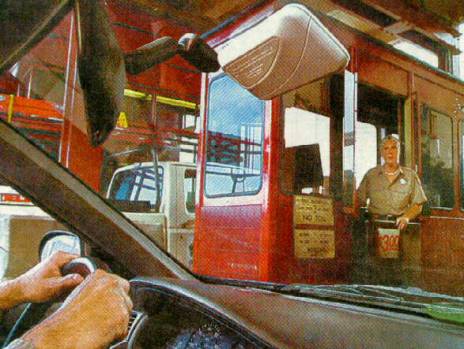E-toll era arrives
on Golden Gate
By Mark
Prodo
IJ reporter

TOLL
TEST: A
car-mounted transponder (white box on windshield) is being tested
as part of an electronic toll system
on the Golden Gate Bridge.
$7 million system starts next week
Anything to make the commute better. That has been the lament of southbound morning commuters for years. Golden Gate Bridge officials say things will start to improve a week from today. That’s when the much-ballyhooed $7 million electronic toll system known, as FasTrak will officially come online at the bridge’s toll plaza.
INTERESTED?
Drivers interested in electronic tolls can provide their
names and mailing addresses by e-mailing fastrak@goldengate.org or by
calling 877-GGB-TOLL. For updates on the project, visit the bridge
district’s Web site at www.goldengate.org.
When the system gets up and running at full speed, bridge officials predict commuters will see less congestion around the toll plaza. “I like it very much,” said Elizabeth Hart of Sausalito, one of about 2,400 people who already have electronic transponders mounted in their vehicles as part of a test group. “It relieves some of the pressure of having to find the bridge ticket, stopping and rolling down your window. You just go right on through.”
Bridge officials say that so fare they are pleased with the testing. The transponders are free for motorists who set up prepaid accounts. The devices, supported by two Velcro strips, can be mounted inside the windshield behind the rearview mirror. As drivers pass by the booth, the transponder emanates two quick beeps signaling the toll has been deducted from their account. A display sign at the tollbooth notifies motorists that the toll has been accepted. Officials recommend driving through at about 5mph.
The bridge handles about 6,000 cars an hour through the tollbooths during the peak morning commute. When the electronic toll system is up and running as many as 7,200 vehicles will be able to move through the toll booth, often a choke point for traffic. About 120,000 vehicles pass over the bridge every day. “We are not widening the bridge, so traffic will still go up the Waldo Grade, but it will move things more quickly through the toll plaza,” Currie said. When the system comes fully online next Thursday, there won’t be a dedicated for FasTrack users. That is expected to happen later as more people sign up.
The arrival of the electronic toll system means the eventual end of discount toll tickets, which motorist currently buy ahead of time and get a 33-cent break on the price of the $3 single fare. The tickets, sold in booklets, will be phased out 90 days after FasTrak starts. While motorists using electronic tolls will continue to get the 33-cent discount, the price break may be eliminated after a year of the FasTrak program.
Bridge officials have said that keeping the discount system in place could create a loss of up to $13.7 million in toll revenue over the first 10 years of the program. While 35 percent of drivers who pass through the tolls currently take advantage of the discount, the figure could jump to 65 percent by 2006 if the expected popularity of FasTrak pans out. “It is something the board will look at. There will be public hearings,” Curie said. San Anselmo commuter Lin Ivory is happy to the see the system ready to launch. “It’s about time. I think it will be great,” she said.
Contact reporter Mark Prado via e-mail at mprado@marinij.com